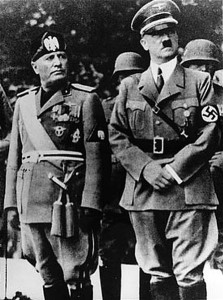Gorlizki and Mommsen along with Schivelbusch present information regarding the political rise and eventual control of the Nazi Party in Germany under Hitler, and the Communist Party in the USSR under Stalin. Mommsen and Gorlizki conclude that, in addition to a variety of economic, agricultural, and social reasons, Stalin and his party maintained control over its subordinates so well through the “centralized and institutionally integrated party” ((Gorlizki and Mommsen, 85)) which essentially formed the core of the state. Gorlizki and Mommsen go on to discuss the rise of Hitler and the Nazi party in Germany, and they contend that “the state
and ideology relied to a far greater extent for what coherence they had on the
cult of the Fuhrer.” ((Gorlizki and Mommsen, 85)) This concept of a “cult of the Fuhrer” is a concept touched upon (and explained in detail) by Schivelbusch. In Schivelbusch’s chapter entitled “Leaders”, he contends that Adolf Hitler had an extraordinary ability to “speak to the soul of the people” ((Schivelbusch, 54)), which (as Gorlizki and Mommsen mentioned) helped create the “cult of the Fuhrer”, or, in more simple terms, the love of the German people for their leader contributed greatly to the success garnered by Hitler and the Nazi party; the people of Germany, (unlike the people of the USSR, who as pointed out by Mommsen and Gorlizki became infatuated with, and allowed for the development of “the party”), allowed Hitler to become larger than life.
The idea of leadership and its evolution and importance in the USSR and Germany is an important area to look at in order to bring context to our class, but since Schivelbusch touched on Roosevelt, it would be interesting to bring more context to the American political sphere of that time, and see how closely the opinions of Roosevelt held by the American people parralled with the opinions of German and Soviet citizens with regard to their respective rulers.

